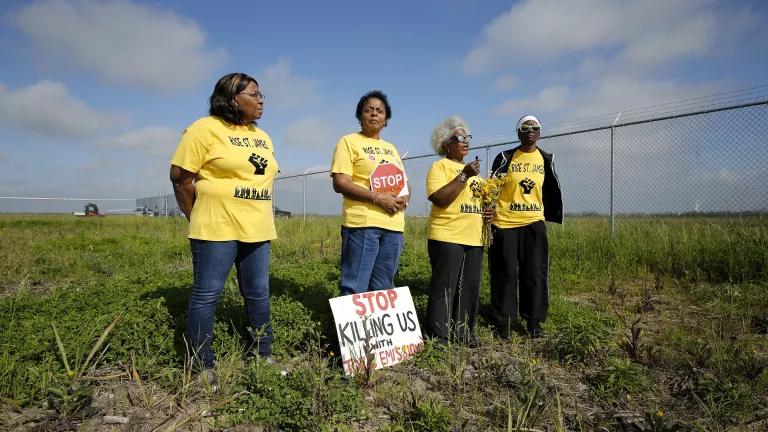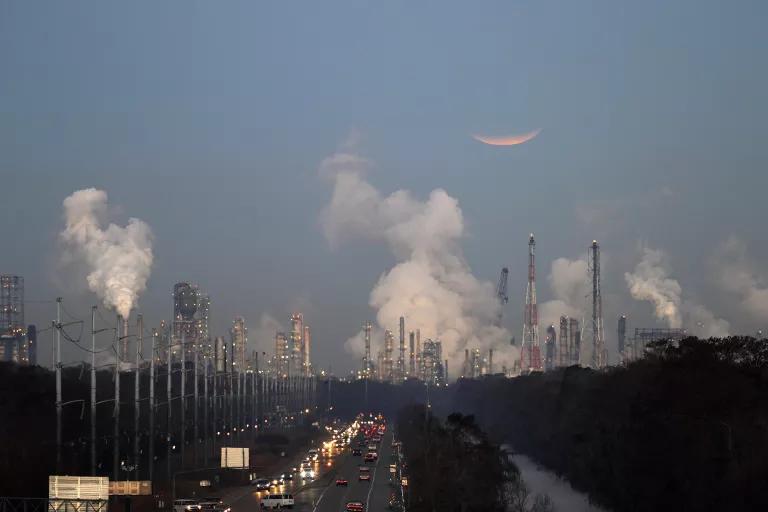Advocates Are Sparking a Revolution in Louisiana's “Cancer Alley”
Residents of St. James Parish are fighting to boot harmful petrochemical plants from this majority-Black community—and hoping to usher in more sustainable industries like solar.

RISE St. James founder Sharon Lavigne (center) and the group’s members conducting a live stream on Formosa Plastics–owned property
UPDATE: On January 19, 2024, a Louisiana appellate court vacated the 2022 decision to deny air pollution permits for the proposed Formosa Plastics petrochemical plant. Yet the local community continues to fight the project on other fronts. For instance, in order to build the plant, the company still needs a wetlands permit from the U.S. Army Corps of Engineers.
When Sharon Lavigne first uttered the phrase “Stop Formosa Plastics,” she didn’t know it would become a rallying cry heard around the world. Or that four years after she first spoke out against the construction of a proposed $9.4 billion petrochemical plant two miles from her home in the majority-Black Fifth District of St. James Parish, Louisiana, her demand would actually be met (at least for now). In September, Judge Trudy White of the 19th Judicial District Court canceled the air permits for the Formosa Plastics plant. Last month, the U.S. Environmental Protection Agency (EPA) also finally recognized this environmental racism and called on Louisiana regulators to analyze the cumulative impacts of polluting industries on nearby residents.
“I feel like I’m on top of the world,” says Lavigne, who started RISE St. James, a faith-based grassroots environmental justice group, in October 2018. “I feel like we did the impossible.”
Back in 2018, Taiwan-based Formosa Plastics began looking to build a 2,400-acre complex on the western bank of the Mississippi River, the largest of its kind. St. James Parish is already home to a dozen petrochemical plants that are concentrated in the district where Lavigne’s family has lived for generations. So when news came in that yet another company had plans to move in and pollute, despondency set in with many residents.

Lavigne felt differently. “I sat on my porch, and I spoke to God,” she says. “God answered me, and he put this fight in me that no one could take.” From there, the retired special education teacher set her sights not only on stopping Formosa Plastics but the petrochemical industry’s expansion in St. James Parish more broadly. She learned all she could about toxic chemical and greenhouse gas pollution. She attended community meetings. She organized protests. And, eventually, she says, she ditched using notes when speaking in public, preferring instead to just “let God’s words flow through her.”
“I was told when the governor approved this plan, it was a done deal, and there was nothing I could do about it,” Lavinge says about the proposed plant. “Well, look at me now. Look at it now.”
The battle over the Formosa plant, however, is just one in a larger war to transform the region into a place where more sustainable industries and healthier communities can thrive. To that end, companies are eager to build solar farms in the area, but as too often is the case in a place dubbed “Cancer Alley,” change is hard-won.

Cancer Alley: A sacrifice zone
Sharon’s daughter Shamyra grew up surrounded by the chemical plants. White smoke constantly billowed from tall metal towers—”the closest thing to skyscrapers in our community,” Shamyra says. She remembers wondering as a young girl if that might be where Santa Claus made toys. To her, this scene was normal. She never knew anything different. “I didn't think that it was harmful because it was right there in our faces,” she says.
But soon, Shamyra put the pieces together. First there was the yellow dust, a byproduct of the plants’ chemical releases, that covered their cars and yards. Then there were noxious smells, and the breathing problems and other health issues experienced by family, friends, and neighbors. “If you do not have cancer yourself, you know someone who has cancer,” Shamyra says of fellow St. James Parish residents. After learning in college of her region’s unfortunate nickname, the sheer number of cancer patients she knew finally made sense. “We feel lost. We feel rejected,” she says. “We feel like people have just left us out to die.”
Cancer Alley is an 85-mile stretch that encompasses seven parishes between Baton Rouge and New Orleans. About a quarter of the country’s total petrochemical production, and several pipelines, oil refineries, and other gas and oil operations add to this region’s toxic load. And here, the health problems disproportionately impact predominantly Black communities, where the majority of the polluting facilities operate. Of the 10 census tracts with the country’s highest cancer risk levels from air pollution, seven are in Cancer Alley. According to the EPA, the town named Reserve has the country’s highest cancer risk—50 times the national average.

But it wasn’t always that way in St. James. Sharon Lavigne reminisces about her happy and healthy childhood. Her family, like many others, lived off the parish’s fertile land, and she remembers clean air and water, vegetable gardens, and fruit trees. Her father was a self-employed sugarcane farmer, and they drank milk from his cows and ate eggs from his chickens.
But by the late 1960s, the first chemical plants started moving in. They promised residents secure and well-paying jobs. According to a 1995 survey, however, only 9 percent of permanent, full-time industry positions in nearby St. Gabriel were held by locals. Shamyra says RISE’s fight is about the industries, not about the workers. “We understand you want to take care of your family. We just want to make sure you're not polluting us in the meantime,” she says. “We’re not against jobs, but we want green jobs.”
By the 1980s, the area had become the country’s de facto headquarters for the petrochemical industry, sparking concerns about health impacts and giving rise to the moniker “Cancer Alley.” In St. James Parish, a 2014 land use plan—created by local government officials without community involvement—made it particularly easy for industry to set up shop by rezoning the majority-Black Fourth and Fifth Districts to “residential/future industrial.”
“Looking back, if my grandfather could see what's going on right now, I think he would be fighting against these chemical plants as well,” Shamyra says. “I think that generation would choose a different path.”
Solar: A brighter path
As of last year, companies have proposed at least 16 big solar projects for Louisiana, three in St. James alone. But in mid-August, the St. James Parish Council placed a moratorium on the farms’ construction until at least March 2023, citing the need for an economic and environmental study. Local residents also worried about aesthetics and safety of the expansive solar arrays. The idea for a moratorium came up just a couple months after the parish’s planning commission denied a proposal for a 3,900-acre solar project in the town of Vacherie.
Lavigne was outraged that the council would place a moratorium on solar farms while it continued to roll out the red carpet for polluting industries. “Petrochemical plants are the thing that's killing us, not the solar panels,” she says.
She’s not alone. Other residents, and even Entergy, Louisiana’s main electricity provider, are also concerned about the region missing a critical opportunity to invest in solar energy—especially after this summer’s passage of the Inflation Reduction Act. The law promises to dedicate 40 percent of climate-related funding to historically disadvantaged communities, and this could help boost clean energy production and create jobs. “Despite the opportunities that might be available in the Inflation Reduction Act, their plan is to continue to industrialize St. James Parish, specifically the Black districts,” says Anne Rolfes, director of Louisiana Bucket Brigade, a New Orleans–based nonprofit that supports communities harmed by the petrochemical industry.
Shamyra believes the financial incentives the petrochemical industry provides—for instance, buying the high school football team new uniforms or building a new community park—help local politicians justify public support for these polluters. “That is not going to work if the children can't breathe the air while they're playing at the park,” she says. Yet local taxpayers are subsidizing these companies: Local and state governments in Louisiana offered Formosa Plastics $1.5 billion in tax breaks to set up shop in St. James Parish.
While Shamyra’s vision for the future extends beyond the expansion of solar—a strong community with good jobs and good health, one that demands transparency and invests in its young people—the solar farms are a good place to start. Community advocates are waiting to take the next steps once the moratorium period ends.

A path against polluters
While fending off Formosa Plastics has been RISE St. James’s most visible fight, it hasn’t been its only one. In 2019, less than a year after Chinese-owned chemical company Wanhua proposed a $1.25 billion plastics manufacturing plant in St. James Parish, it canceled the project. Lavigne’s activism in this was recognized with a 2021 Goldman Prize.
And just last month, days before the Formosa announcement, RISE celebrated the defeat of South Louisiana Methanol, a proposed $2.2 billion methanol plant (the largest facility of its kind in North America) that would have emitted 2 million tons of greenhouse gases every year. The plant had been sited next to Welcome Park, the only park in the Fifth District. South Louisiana Methanol was among the onslaught of companies, including Wanhua and Formosa Plastics, vying to set up shop in St. James Parish after local officials finalized the zoning changes in the 2014 land use plan.
The proposed petrochemical plant still hangs on by a thread. Formosa Plastics is vowing to challenge the ruling, claiming that the Louisiana Department of Environmental Quality had used selective and inconsistent data when issuing its permits. If built, the enormous plant would release more than 13 million tons of greenhouse gases every year—the equivalent of 3.5 coal-fired power plants—in addition to carcinogenic chemicals like ethylene oxide. Together, the emissions would more than double the toxic load in St. James Parish’s air.

Another key factor in Judge White’s opinion was the history of slavery in the area, the proximity of Formosa’s complex to enslaved people’s gravesites, including Lavigne’s grandmother’s, and the present day impacts it would have on the “descendants of men and women who were kidnapped from Africa; who survived the Middle Passage; who were transported to a foreign land; and then sold on auction blocks.”
Rolfes says the decision was “a blistering one,” and thinks Formosa Plastics’ appeal of the decision is an attempt to “try to claw back some of [its] own dignity” after being soundly defeated. She warns that the project is certainly not dead, and her group will continue to keep an eye on its status. “It wouldn't be a surprise to any of us if they try to put it someplace else in Louisiana,” she says. “Of course, that's unacceptable.”
The Lavignes also plan to keep up the fight, with one hand fighting past injustices and the other reaching for a cleaner, healthier future.
This NRDC.org story is available for online republication by news media outlets or nonprofits under these conditions: The writer(s) must be credited with a byline; you must note prominently that the story was originally published by NRDC.org and link to the original; the story cannot be edited (beyond simple things such as grammar); you can’t resell the story in any form or grant republishing rights to other outlets; you can’t republish our material wholesale or automatically—you need to select stories individually; you can’t republish the photos or graphics on our site without specific permission; you should drop us a note to let us know when you’ve used one of our stories.

The Particulars of PM 2.5
From Memphis to the White House, This Advocate Is Confronting Redlining and Environmental Injustice
Environmental Justice in Chicago: It’s Been One Battle After Another